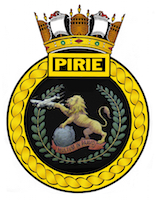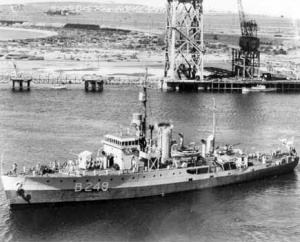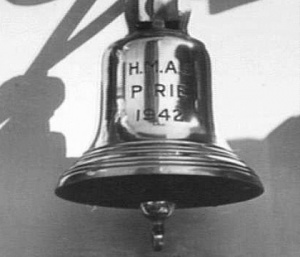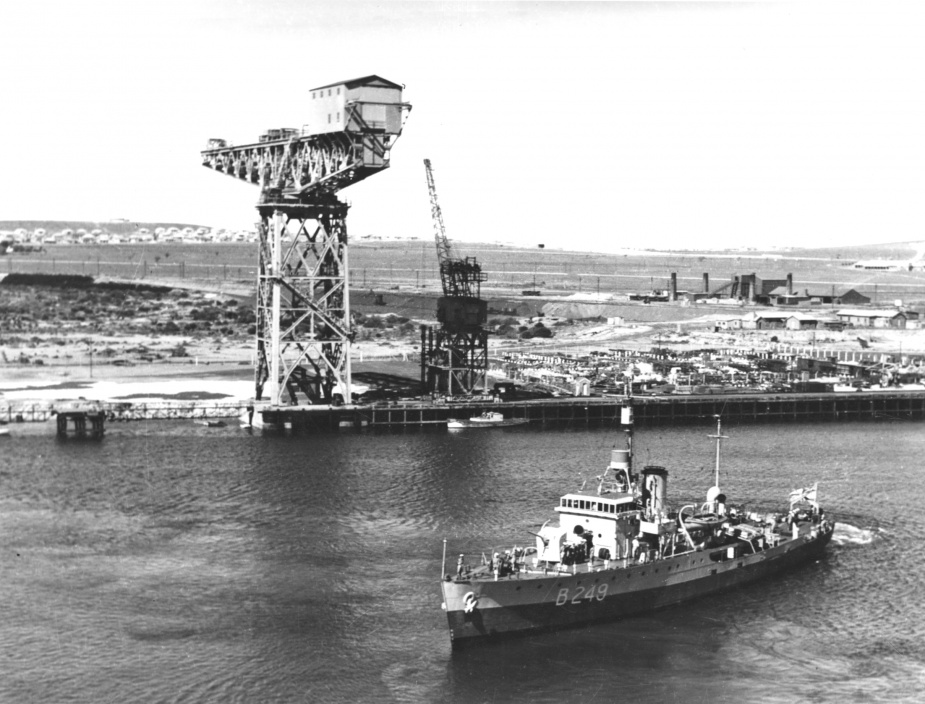HMAS Pirie (I)
| Class |
Bathurst Class |
|---|---|
| Type |
Australian Minesweeper |
| Pennant |
J189 |
| Builder |
Broken Hill Pty Ltd, Whyalla |
| Laid Down |
19 May 1941 |
| Launched |
3 December 1941 |
| Launched by |
Mrs Kleeman, wife of Whyalla Superintendent, Broken Hill Pty Ltd |
| Commissioned |
10 October 1942 |
| Decommissioned |
5 April 1946 |
| Fate |
Transferred to the Turkish Navy in which she served until 1984 |
| Dimensions & Displacement | |
| Displacement | 733 tons |
| Length | 186 feet |
| Beam | 31 feet |
| Draught | 8 feet 6 inches |
| Performance | |
| Speed | 15 knots |
| Complement | |
| Crew | 85 |
| Propulsion | |
| Machinery | Triple expansion, 2 shafts |
| Horsepower | 2,000 |
| Armament | |
| Guns |
|
| Other Armament |
|
| Radars |
|
| Sonars | Type 128 BC ASDIC |
| Awards | |
| Battle Honours | |

HMAS Pirie was one of sixty Australian Minesweepers (commonly known as corvettes) built during World War II in Australian shipyards as part of the Commonwealth Government's wartime shipbuilding programme. Twenty (including Pirie) were built on Admiralty order but manned and commissioned by the Royal Australian Navy. Thirty six were built for the Royal Australian Navy and four for the Royal Indian Navy.
HMAS Pirie was laid down on 9 May 1941 and was launched by Mrs Kleeman, wife of Whyalla Superintendent, Broken Hill Pty Ltd on 3 December 1941. She commissioned at Whyalla on 10 October 1942 under the command of Lieutenant Commander Charles F Mills, RAN (Emergency List).
Pirie completed her working up period in home waters in December 1942 before being assigned to convoy escort duty operating between Queensland, New South Wales and New Guinea.
She was at Milne Bay on 24 March 1943, when 27 enemy aircraft passed overhead en route to attack shore targets. Off Oro Bay (New Guinea) on 11 April 1943, Pirie was escorting the British vessel SS Hanyang as part of Operation LILLIPUT, the reinforcement, supply and development of the Buna-Gona area after its capture. Pirie was subjected to a particularly determined attack by a large force of Japanese fighters and dive bombers. She experienced six very close misses and one direct hit which struck the bullet proof canopy over the bridge, penetrated it, glanced off the helmsman's protective apron, struck and killed instantly the Gunnery Officer and then striking the upper deck, exploded killing six ratings and wounding four others. Fortunately after hitting Pirie the enemy broke off the attack having lost several aircraft hit by close range anti-aircraft fire.
Repairs were completed in May 1943 and Pirie resumed operations escorting convoys proceeding between the Australian east coast and New Guinea. At this time Japanese offensive submarine operations in Australian waters were drawing to a close after being active for several months. Following Pirie's return to service only two ships were lost in Australian waters as a result of Japanese submarine attacks. These were the hospital ship Centaur, which was lost with 268 lives on 14 May 1943, and the United States vessel SS Protmar, which was torpedoed and sunk off the New South Wales coast on 16 June 1943.
Pirie was under refit at Garden Island from mid-November to early December 1943.
From April to July 1944 Pirie was mainly engaged in escorting convoys moving along Australia's northern coast between Thursday Island and Darwin. In August 1944 she was assigned to duty as a minesweeper and assisted by her sister ship HMAS Kalgoorlie (I) began a series of clearing sweeps of defensive minefields in the Great Barrier Reef area. This task was completed at the end of September 1944 and after a refit at Brisbane Pirie sailed for Fremantle in mid December. On 24 November 1944 the ship had been designated as a unit of the 22nd Minesweeping Flotilla on its reformation.
On 31 January 1945 Pirie sailed from Fremantle for Sydney and from there on 24 February, sailed for Manus (Admiralty Islands) as a unit of the British Pacific Fleet. From Manus she proceeded to the Philippines and thereafter until hostilities ended, excepting for three weeks spent in Brisbane in June, she was almost constantly at sea acting as an escort vessel to units of the Fleet. Pirie also participated in the operation for the capture of Okinawa (March to May 1945).
On 31 August 1945 Pirie entered Tokyo Bay, being the third Australian warship to enter Japanese home waters since hostilities commenced, preceded only by the destroyers HMA Ships Napier and Nizam. In mid-September she proceeded to Hong Kong where she was engaged on local patrol duty until 11 October 1945, when she sailed to return to Australia. She reached Brisbane on 30 October 1945. After service in Australian waters, which included a visit to her namesake town of Port Pirie, the ship arrived at Sydney on 28 February 1946. She had steamed a total of 117,230 miles since commissioning in October 1942.
On 5 April 1946, at Sydney, Pirie paid off and recommissioned in the Royal Navy as HMS Pirie. On 21 May 1946 she sailed for Colombo in company with her sister ships Gawler and Launceston. All were destined for transfer to the Turkish Navy.
As a unit of the Turkish Navy Pirie was renamed Amasra. The vessel was not listed in 'Jane's Fighting Ships' after the 1971/72 issue. In 1984, in answer to a query from the HMAS Pirie Association, the Turkish Consulate General advised that 'Amasra was put out of service on 26 March 1984 after having rendered valuable service to the Turkish Navy'.
Further reading
- 'The Corvettes: Forgotten Ships of the Royal Australian Navy' by Iris Nesdale - published by the Author, October, 1982.
- 'Notable Service to the Empire: Australian Corcettes and the British Pacific Fleet 1944-45' by Hugh Campbell - published by Naval Historical Society of Australia, Inc, 1995.
- 'Corvettes - Little Ships for Big Men' by Frank B Walker - published by Kingfisher Press, NSW, 1996.
- 'The Australian Centenary History of Defence Volume III, The Royal Australian Navy', Edited by David Stevens, Oxford University Press, South Melbourne, Victoria, Australia, 2001.














